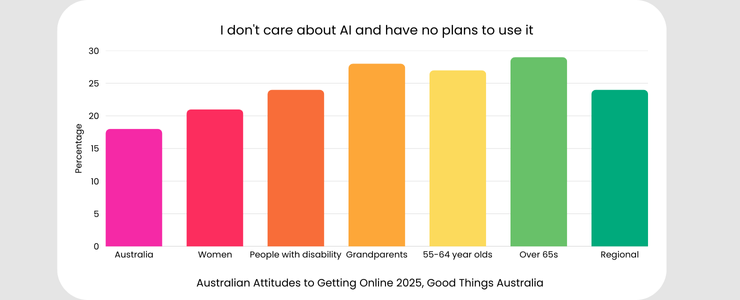AI is rapidly changing how we use tech, work, learn and play. Our research indicated that AI has the potential to make Australia more inclusive by:
- Creating opportunities
- Increasing access to services
- Making workplaces more effective
- Supporting us to solve big problems.3
But to achieve this vision, we need to use and distribute AI technology ethically and equally.
This National AI Week, we have summarised the latest research on AI and digital inclusion to help you understand its impact.
Use of AI
The recent Australian Digital Inclusion Index found that almost half of Australians have recently used generative AI (Gen AI).1 Usage of it varies, with 26% of people actively using AI to help resolve tech problems,2 and 65% of recent users saying they did so because they were curious,4 showing the motivation to have a go at using the new tech is there for many.
Some are already seeing how it can help them and have a positive attitude towards building the skills needed to use the technology. 46% of Australian adults want to learn more about Gen AI.4 32% say they’re excited to learn about AI, with this rate rising to 62% First Nations people, and 40% of people born overseas.2
Those more likely to use Gen AI at the moment are:
- Professionals & managers
- People who speak a language other than English at home
- Students
- People with higher levels of education
- Younger people.1

But, this attitude and skill level is not universal. Many are struggling to keep up with the rapid tech changes or are worried about AI. 23% of people say that they are struggling to use AI tools or apps, rising to 35% of grandparents.2 This was the essential digital skill that respondents were most likely to say they found difficult of the ten tested in this research.
As generative AI continues to advance but remains relatively new, nearly 29% Australian adults said that they are unsure how to tell AI created content from real content.2 This uncertainty rises to rising to 33% of women, 41% of over 65’s and 43% among grandparents, highlighting a possible intergenerational and gender gap in media literacy skills or confidence to achieve this skill.
Others don’t want to keep up with this new technology, with 18% of Australian adults saying that they don’t care about AI or want to use it.2 These attitudes were more common among women, people with disability, grandparents, people living in regional areas, and older adults.

Additionally, 1 in 5 said they are worried about what AI will mean for current generations,2 with 3 in 4 agreeing that laws or regulations are needed to manage Gen AI risks.4
Businesses and not for profits
Many businesses and not for profits see the benefits of using AI tools, and teaching AI literacy skills to their community. 45% of Australian health, education and manufacturing small to medium businesses (SMEs) are already using AI in their work.6 A recent survey showed that 67% of not for profits (NFPs) are using Gen AI apps and tools,5 indicating that they are leading the way in technology uptake compared to many other sectors.
This attitude is reflected in 71% of organisations in Good Things network of community organisations said that they think it’s important for their community to learn about AI.3 However, 60% of digital mentors do not feel confident teaching others about AI before our training.7 Given the important role that community organisations have in digital literacy education and social inclusion, this indicates that dedicated support to upskill in this area could be beneficial.
However, implementing AI technology can be tricky and uneven across sectors and business types. Data security, ethics & privacy is the biggest barrier for NFPs in using AI, followed by capability or knowledge gaps and cost of implementation.5 Demonstrative of that is 85% of NFPs not having an AI policy to guide their work and decision making. Meanwhile, only 6% of Agriculture SMEs are using AI, with the sector being one of the later adopters of this new technology.6
We can close the AI divide
What the research shows is that there’s more to do to close the developing AI digital divide so no one is left behind. The rapid implementation of AI has the potential to reverse some of the positive steps that have been made towards creating a more digitally inclusive country, unless action is taken now.
To close the AI divide, Good Things recommends that:
- Community led AI literacy programs are made available for all
- A national digital inclusion strategy is created inclusive of AI literacy
- Everyone has affordable access to the internet, apps and devices, to ensure cost and connectivity are not a barrier to use.
Find out more about our work on AI for Good.
References
Research sources:
- Measuring Australia’s Digital Divide: 2025 Australian Digital Inclusion Index, Thomas, J et al. 2025
- Australian Attitudes to Getting Online 2025, Good Things Australia, Good Things, 2025
- Digital Sisters AI for Good Report: Understanding AI Literacy and Digital Inclusion, Good Things, 2024
- Adult Media Literacy in 2024: Australian Attitudes, Experiences & Needs, Notley et al, 2024
- 2025 Digital Technology in the Not-for-Profit Sector Report, Infoxchange, 2025
- Exploring AI adoption in Australian businesses, National AI Centre/Fifth Quadrant, 2024
- Digital Mentor Skills Checker, Good Things, 2025